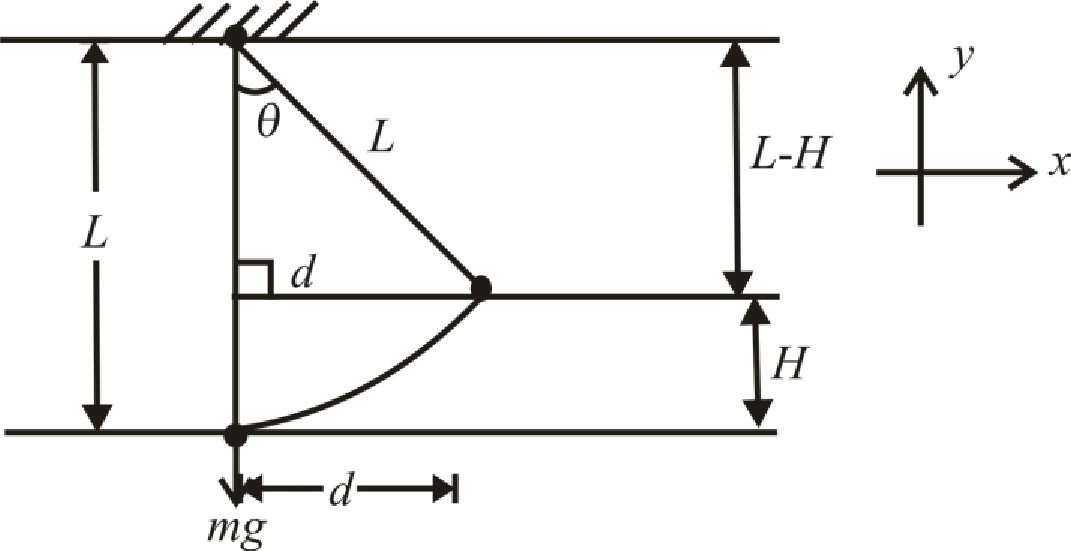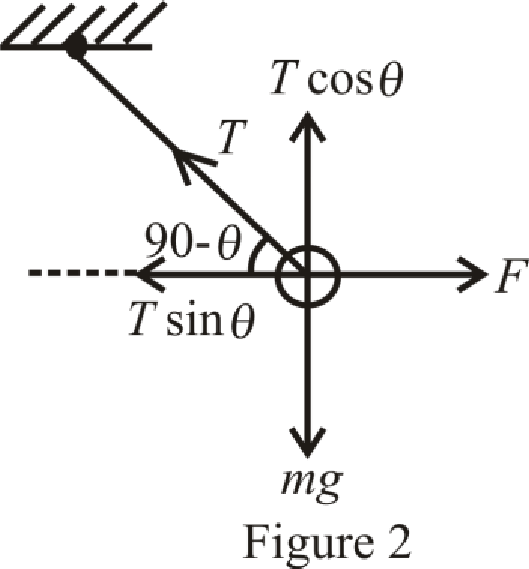
Concept explainers
(a)
The maximum height the ball attains when it swings up.
(a)
Answer to Problem 82CP
The maximum height of the ball when it swings up is
Explanation of Solution
Consider the ball-string-wind as a system under gravitational force.
Since the work done by the wind on the system is transformed into potential energy of the system.
Write the equation for conservation of energy
Here,
Write the expression for the change in potential energy
Here,
Since the kinetic energy of the systems remains zero because in both initial and final cases the system is not in rest.
Write the expression for potential energy
Here,
.
Substitute
Here,
Since the difference in initial and final height is given by
Substitute
Substitute
Simplify the above equation.
Write the expression for work done by the force
Here,
Substitute

Write the expression for distance in the direction of the force exerted from the figure (I).
Here,
Simplify the above equation.
Substitute
Simplify the above equation.
Since one root of the above equation is zero, so take non-zero value of
Solve the above equation.
Simplify the above equation to find the expression for
Conclusion:
Substitute
Simplify the above equation.
Thus, the maximum height of the ball when it swings up is
(b)
The maximum height the ball attains when the force exerted by wind is
(b)
Answer to Problem 82CP
The maximum height attained by the ball, when the force exerted by wind is
Explanation of Solution
Conclusion:
Substitute
Thus, the maximum height attained by the ball, when the force exerted by wind is
(c)
The maximum height the ball attains when the force exerted by wind is
(c)
Answer to Problem 82CP
The maximum height attained by the ball, when the force exerted by wind is
Explanation of Solution
Consider the equation (V) for the maximum height attained due to the force exerted by the wind.
The ball swings in the upward direction by the wind force exerted on the ball.
Conclusion:
Substitute
Thus, The maximum height attained by the ball, when the force exerted by wind is
(d)
The maximum height when the force exerted by wind approaches to zero.
(d)
Answer to Problem 82CP
The maximum height approaches to zero when
Explanation of Solution
Write the expression for the maximum height in the limit form as.
Substitute
Conclusion:
Thus, the maximum height approaches to zero when
(e)
The behavior of maximum height when the force exerted by wind approaches to infinity.
(e)
Answer to Problem 82CP
The maximum height approaches to
Explanation of Solution
Write the expression for the maximum height in the limit form as.
Substitute
Thus, the maximum height approaches to
(f)
The equivalent height of the ball with the wind blowing.
(f)
Answer to Problem 82CP
The equivalent height of the ball with the wind blowing is
Explanation of Solution
Consider the system in an equilibrium state with net force zero as shown in figure (II).

Write the equation for net force in a vertical direction from the figure (II)
Here,
When the ball-string system is in equilibrium, the net force will be zero in all directions.
Here,
Substitute
Simplify the above equation.
Write the equation for net force in a horizontal direction from the figure (II)
Here,
Substitute
Simplify the above equation.
Divide equaiton (VIII) by equation (VII).
Write the expression for
Substitute
Write the expression for equivalent height from the figure (II).
Here,
Substitute
Conclusion:
Substitute
Substitute
Simplify the above expression as.
Thus, the equivalent height of the ball with the wind blowing is
(g)
The equivalent height when
(g)
Answer to Problem 82CP
The equivalent height when
Explanation of Solution
Conclusion:
Substitute
Thus, the equivalent height when
(h)
The equivalent height when the force exerted by wind approaches to infinity.
(h)
Answer to Problem 82CP
The equivalent height when the force exerted by wind approaches to infinity is
Explanation of Solution
Consider the equivalent height from the equation (XII).
Write the expression for equivalent height from the equation (XII).
Write the equation for
Substitute
Conclusion:
Thus, the equivalent height when the force exerted by wind approaches to infinity is
Want to see more full solutions like this?
Chapter 8 Solutions
Physics for Scientists and Engineers with Modern Physics, Technology Update
- How can I remember this Formula: p = m × v where m is in kg and v in Meter per second in the best way?arrow_forwardHow can I remember the Formula for the impulsearrow_forwardA Geiger-Mueller tube is a radiation detector that consists of a closed, hollow, metal cylinder (the cathode) of inner radius ra and a coaxial cylindrical wire (the anode) of radius г (see figure below) with a gas filling the space between the electrodes. Assume that the internal diameter of a Geiger-Mueller tube is 3.00 cm and that the wire along the axis has a diameter of 0.190 mm. The dielectric strength of the gas between the central wire and the cylinder is 1.15 × 106 V/m. Use the equation 2πrlE = 9in to calculate the maximum potential difference that can be applied between the wire and the cylinder before breakdown occurs in the gas. V Anode Cathodearrow_forward
- 3.77 is not the correct answer!arrow_forwardA I squar frame has sides that measure 2.45m when it is at rest. What is the area of the frame when it moves parellel to one of its diagonal with a m² speed of 0.86.c as indicated in the figure? >V.arrow_forwardAn astronent travels to a distant star with a speed of 0.44C relative to Earth. From the austronaut's point of view, the star is 420 ly from Earth. On the return trip, the astronent travels speed of 0.76c relative to Earth. What is the distance covered on the return trip, as measured by the astronant? your answer in light-years. with a Give ly.arrow_forward
- star by spaceship Sixus is about 9.00 ly from Earth. To preach the star in 15.04 (ship time), how fast must you travel? C.arrow_forwardIf light-bulb A is unscrewed, how will the brightness of bulbs B and C change, if at all? How does the current drawn by from the battery change?arrow_forwardCan someone help mearrow_forward
- Can someone help me with this thank youarrow_forward(a) For a spherical capacitor with inner radius a and outer radius b, we have the following for the capacitance. ab C = k₂(b- a) 0.0695 m 0.145 m (8.99 × 10º N · m²/c²)( [0.145 m- 0.0695 m × 10-11 F = PF IIarrow_forwardA pendulum bob A (0.5 kg) is given an initialspeed of vA = 4 m/s when the chord ishorizontal. It then hits a stationary block B (1kg) which then slides to a maximum distanced before it stops. Determine the value of d.The coefficient of static friction between theblock and the plane is μk = 0.2. The coefficientof restitution between A and B is e = 0.8.Ans: d=1.0034 marrow_forward
 Physics for Scientists and Engineers: Foundations...PhysicsISBN:9781133939146Author:Katz, Debora M.Publisher:Cengage Learning
Physics for Scientists and Engineers: Foundations...PhysicsISBN:9781133939146Author:Katz, Debora M.Publisher:Cengage Learning Principles of Physics: A Calculus-Based TextPhysicsISBN:9781133104261Author:Raymond A. Serway, John W. JewettPublisher:Cengage Learning
Principles of Physics: A Calculus-Based TextPhysicsISBN:9781133104261Author:Raymond A. Serway, John W. JewettPublisher:Cengage Learning College PhysicsPhysicsISBN:9781938168000Author:Paul Peter Urone, Roger HinrichsPublisher:OpenStax College
College PhysicsPhysicsISBN:9781938168000Author:Paul Peter Urone, Roger HinrichsPublisher:OpenStax College Physics for Scientists and Engineers with Modern ...PhysicsISBN:9781337553292Author:Raymond A. Serway, John W. JewettPublisher:Cengage Learning
Physics for Scientists and Engineers with Modern ...PhysicsISBN:9781337553292Author:Raymond A. Serway, John W. JewettPublisher:Cengage Learning Physics for Scientists and EngineersPhysicsISBN:9781337553278Author:Raymond A. Serway, John W. JewettPublisher:Cengage Learning
Physics for Scientists and EngineersPhysicsISBN:9781337553278Author:Raymond A. Serway, John W. JewettPublisher:Cengage Learning College PhysicsPhysicsISBN:9781285737027Author:Raymond A. Serway, Chris VuillePublisher:Cengage Learning
College PhysicsPhysicsISBN:9781285737027Author:Raymond A. Serway, Chris VuillePublisher:Cengage Learning





